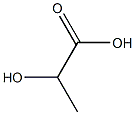Polylactic acid , Mw~60,000 , 26100-51-6
Synonym(s):
PLA;PLLA acetylene;PLLA acrylate;Poly(2-hydroxypropionic acid);propargyl PLLA
CAS NO.:26100-51-6
Empirical Formula: (C3H6O3)x
Molecular Weight: 90.0779
MDL number: MFCD00081867
EINECS: 201-245-8
| Pack Size | Price | Stock | Quantity |
| 1G | RMB606.40 | In Stock |
|
| 5G | RMB1599.20 | In Stock |
|
| 25g | RMB4799.20 | In Stock |
|
| 100g | RMB15199.20 | In Stock |
|
| others | Enquire |
PRODUCT Properties
| Melting point: | 176℃ |
| Density | 1.25-1.28 g/cm3 |
| refractive index | 1.4589 |
| storage temp. | 2-8°C |
| form | powder |
| color | black |
| optical activity | [α]22/D -145°, c = 0.1% in chloroform |
| EPA Substance Registry System | Polylactic acid (26100-51-6) |
Description and Uses
Polylactic acid(PLA) was introduced in 1966 for degradable surgical implants. Hydrolysis yields lactic acid, a normal intermediate of carbohydrate metabolism. Polyglycolic acid sutures have a predictable degradation rate which coincides with the healing sequence of natural tissues.
Polylactic acid, also known as polylactide, is prepared from the cyclic diester of lactic acid (lactide) by ring-opening addition polymerization. Pure DL-lactide displays greater bioresorbability, whereas pure poly-Llactide is more hydrolytically resistant.
The actual time required for poly-L-lactide implants to be completely absorbed is relatively long, and depends on polymer purity, processing conditions, implant site, and physical dimensions of the implant.
Safety
| Hazard Codes | Xi |
| Risk Statements | 36 |
| Safety Statements | 22-24/25-26 |
| WGK Germany | 3 |
| F | 10-21 |
| Hazardous Substances Data | 26100-51-6(Hazardous Substances Data) |





